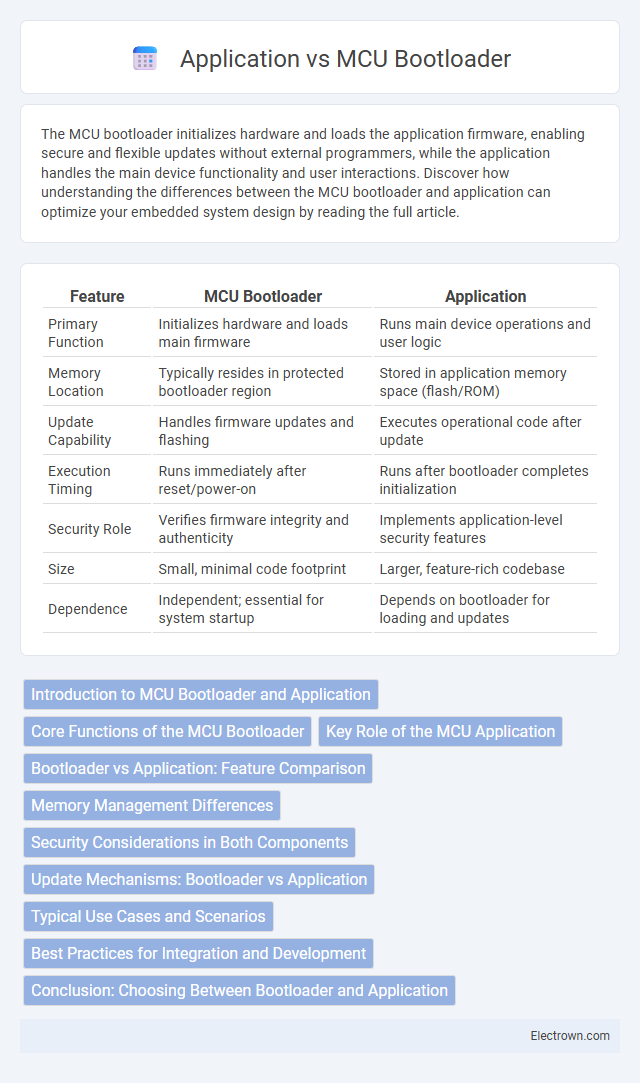The MCU bootloader initializes hardware and loads the application firmware, enabling secure and flexible updates without external programmers, while the application handles the main device functionality and user interactions. Discover how understanding the differences between the MCU bootloader and application can optimize your embedded system design by reading the full article.
Table of Comparison
| Feature | MCU Bootloader | Application |
|---|---|---|
| Primary Function | Initializes hardware and loads main firmware | Runs main device operations and user logic |
| Memory Location | Typically resides in protected bootloader region | Stored in application memory space (flash/ROM) |
| Update Capability | Handles firmware updates and flashing | Executes operational code after update |
| Execution Timing | Runs immediately after reset/power-on | Runs after bootloader completes initialization |
| Security Role | Verifies firmware integrity and authenticity | Implements application-level security features |
| Size | Small, minimal code footprint | Larger, feature-rich codebase |
| Dependence | Independent; essential for system startup | Depends on bootloader for loading and updates |
Introduction to MCU Bootloader and Application
MCU bootloader is a small program stored in the microcontroller's memory that initializes hardware and enables firmware updates without external programming devices. The application is the main firmware that runs user-defined functions and controls the device's operations after the bootloader has completed its tasks. Your system relies on the bootloader for secure and efficient software management, while the application delivers the core functionality.
Core Functions of the MCU Bootloader
The MCU Bootloader performs essential core functions such as initializing hardware components, verifying firmware integrity through secure authentication, and managing the seamless loading of the main application firmware into memory. Your device relies on the bootloader to enable secure updates, recover from corrupted firmware, and facilitate communication protocols for firmware transfer. These capabilities ensure reliable startup sequences and maintain system stability throughout the device lifecycle.
Key Role of the MCU Application
The MCU application handles the main functional tasks of the embedded system, executing control algorithms and managing peripherals based on user inputs or sensor data. It operates after the bootloader has verified and loaded the program, ensuring system stability by running the core firmware. Your device relies on the application to deliver intended performance, responsiveness, and reliability in real-time operation.
Bootloader vs Application: Feature Comparison
The MCU bootloader manages firmware updates, ensures secure startup, and enables recovery without external programmers, while the application executes the main functional code to perform the device's intended tasks. Bootloaders support features like firmware integrity verification, multiple communication interfaces (UART, USB, CAN), and rollback mechanisms, whereas applications focus on processing sensor data, controlling peripherals, and executing user-defined logic. Memory partitioning is critical, with the bootloader occupying protected flash sectors to prevent overwriting, whereas the application resides in the remaining flash space for normal operation.
Memory Management Differences
MCU bootloader and application differ significantly in memory management; the bootloader occupies a small, fixed memory region designed for firmware updates and system initialization, while the application uses the larger, remaining flash memory for main program code and data storage. The bootloader requires efficient use of limited memory and must ensure safe switching to application code without data corruption. Your MCU memory layout must reserve protected sectors for the bootloader to avoid overwriting during application updates.
Security Considerations in Both Components
MCU bootloaders enforce essential security measures like secure boot, authentication, and encrypted firmware updates to prevent unauthorized code execution and protect device integrity. Application-level security focuses on runtime protections including secure data handling, memory safety, and resistance to exploitation through code hardening and access control mechanisms. Both components must implement robust cryptographic techniques and secure key storage to ensure a trusted chain of custody from boot to application execution.
Update Mechanisms: Bootloader vs Application
MCU bootloaders handle firmware updates by initializing hardware and managing secure communication protocols, allowing seamless application upgrades without external programmers. The application layer executes core functionalities but relies on the bootloader to verify and apply new firmware images, ensuring system integrity during updates. Your device firmware update process is more robust and efficient when the bootloader manages update mechanisms separately from the application code.
Typical Use Cases and Scenarios
MCU bootloaders are primarily used for firmware updates, device recovery, and initial system programming, enabling secure and flexible management of embedded systems. Applications run the main functionality of the device, such as sensor data processing or user interface control, executing permanent operational code after the bootloader completes its task. Your selection between bootloader and application depends on development needs like remote firmware updates or initial system configuration in devices such as IoT sensors, consumer electronics, or industrial controllers.
Best Practices for Integration and Development
Seamless integration between the MCU bootloader and application requires isolating memory regions to prevent overlap and ensuring robust communication protocols such as UART or SPI for reliable firmware updates. Best practices include implementing secure validation techniques like cryptographic signatures to authenticate application code before execution, enhancing system integrity and preventing unauthorized modifications. Optimize development by using modular code structures and maintaining clear version control between bootloader and application to facilitate smooth updates and reduce debugging complexity.
Conclusion: Choosing Between Bootloader and Application
Selecting between an MCU bootloader and an application depends on system requirements such as firmware update flexibility, security needs, and memory constraints. Bootloaders enable in-field firmware updates without external programmers, enhancing maintainability and reducing downtime. Applications prioritize executing core functionalities efficiently but often rely on bootloaders or external methods for updates, making the bootloader essential for long-term device management.
MCU Bootloader vs Application Infographic

 electrown.com
electrown.com